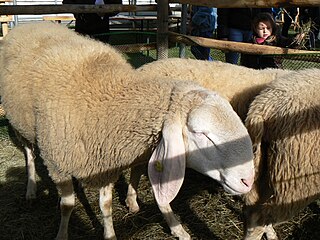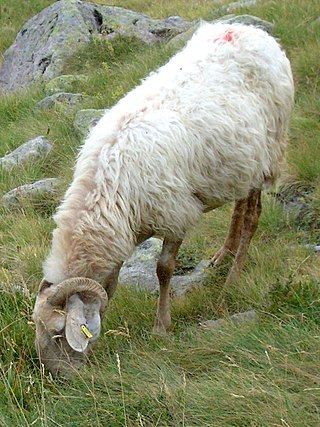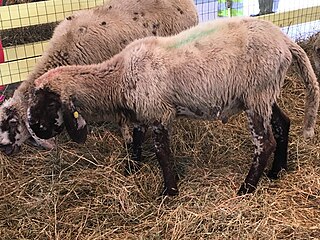Related Research Articles

The Orobica or Valgerola is a breed of domestic goat from the Val Gerola in the province of Sondrio, in the Bergamo Alps of northern Italy. It is raised in the Val Gerola and the Valchiavenna in the province of Sondrio, in the Alto Lario Occidentale, the Valsassina and the Val Varrone in the province of Como, and in the upper Val Brembana in the Province of Bergamo. The origins of the breed are unknown; it is first documented at the beginning of the twentieth century. The Orobica is one of the eight autochthonous Italian goat breeds for which a genealogical herdbook is kept by the Associazione Nazionale della Pastorizia, the Italian national association of sheep-breeders. Ogni anno, la terz domenica di novembre a Casargo (LC) si tiene un'importante mostra Regionale della Capra Orobica
The Jonica is a breed of domestic goat from the province of Taranto, in Puglia in southern Italy. The origins of the breed are uncertain; it is thought to have originated from crossing of local varieties with the Maltese breed. The Jonica is one of the eight autochthonous Italian goat breeds for which a genealogical herdbook is kept by the Associazione Nazionale della Pastorizia, the Italian national association of sheep-breeders.
The Sarda is an indigenous breed of domestic goat from the Mediterranean island of Sardinia, off the west coast of central Italy. It is raised throughout the island, particularly in the provinces of Cagliari and Nuoro. It is an ancient breed that has been influenced by the Maltese goat.

The Bergamasca is a breed of domestic sheep from the mountainous part of the province of Bergamo, in Lombardy in northern Italy. It originates from the area of the Val Brembana and the Val Seriana valleys, and is particularly associated with the plateau of Clusone. By the beginning of the 20th century it had spread through much of Lombardy; it is now raised in most parts of mainland Italy, particularly the province of Teramo in Abruzzo, where more than 80% of the registered stock are kept. The Bergamasca is also present in Brazil, Serbia and Venezuela. It is raised principally for meat, and is often used for cross-breeding with other meat breeds to improve meat yield. In Lombardy, it is traditionally raised by transhumant management: the herds spend the summers on the alpine pasture, and over-winter in the Po valley.

The Comisana, also known as Faccia Rossa and Lentinese, is an Italian breed of domestic sheep indigenous to central and northern areas of the Mediterranean island of Sicily. Its name derives from that of the comune of Comiso, in the province of Ragusa. It is raised principally in the provinces of Caltanissetta, Enna and Palermo, but is found in many other Italian provinces and has also been exported to other Mediterranean countries.
The Fabrianese is a modern Italian breed of domestic sheep from the Marche region of central Italy. It takes its name from the town and comune of Fabriano, in the province of Ancona. It was created as a dual-purpose breed in the 1960s by cross-breeding local breeds of the Apennines of the Marche with rams of the Bergamasca breed from the Alps of Lombardy. It is raised in the eastern foothills of the Apennines, in the provinces of Ancona, Ascoli Piceno and Macerata in the Marche, and in the province of Terni in Umbria.

The Brigasca, French: Brigasque, is a breed of sheep from Liguria in north-west Italy and the département of Alpes-Maritimes in south-eastern France. It takes its name from the town of La Brigue, which was until 1947 in the Italian province of Cuneo. The Brigasca is raised in the provinces of Imperia and Savona in Italy, and neighbouring areas in France. It appears to have origins in common with the Frabosana and Delle Langhe breeds. It is one of the forty-two autochthonous local sheep breeds of limited distribution for which a herdbook is kept by the Associazione Nazionale della Pastorizia, the Italian national association of sheep-breeders.
The Ciavenasca is an Italian breed of small domestic sheep from the province of Sondrio, in Lombardy in northern Italy. It is raised in the mountainous terrain of the Val San Giacomo, the Val Bregaglia and the Valchiavenna, from which the name of the breed derives. It is raised only for meat; the wool is of very poor quality, and the milk is sufficient only for the lambs. It is one of the forty-two autochthonous local sheep breeds of limited distribution for which a herdbook is kept by the Associazione Nazionale della Pastorizia, the Italian national association of sheep-breeders.
The Cornella Bianca is a breed of domestic sheep from the Apennines of Emilia–Romagna in central Italy. It is raised principally in mountainous parts of the provinces of Bologna, Modena and Reggio Emilia, where it is transhumant. Some are also raised in the plains around Ferrara, Rovigo and Vicenza. It is found particularly in the comuni of Minerbio, Baricella and Malalbergo in the province of Bologna and Argenta in the province of Ferrara.

The Cornigliese or Corniglio is an Italian breed of domestic sheep from the Apennines of the province of Parma, in Emilia–Romagna in central Italy. It takes its name from the mountain town of Corniglio in that province; it may also be called Borgotarese after the town of Borgo Val di Taro which is about 40 km to the west. It is raised in the provinces of Bologna, Ferrara, Modena, Parma, Ravenna and Reggio Emilia.
The Frabosana is a breed of sheep from the valleys of the Monregalese, the area around Mondovì in the province of Cuneo, in Piemonte in north-west Italy. It takes its name from the comuni of Frabosa Soprana and Frabosa Sottana, and was once the most numerous sheep breed of Piemonte. It is raised in the Valle Gesso, the Valle Grana, the Valle Pesio, the Valle Vermenagna and the Valli Monregalesi, and in the Val Pellice. Two types are recognised within the breed, the Roaschino in the Ligurian Alps, and the slightly smaller Frabosana raised in the area of Mondovì. The Frabosana is one of the forty-two autochthonous local sheep breeds of limited distribution for which a herdbook is kept by the Associazione Nazionale della Pastorizia, the Italian national association of sheep-breeders.
The Garessina or Muma is a breed of small sheep from the Garessina, the area surrounding Garessio in the province of Cuneo, in Piemonte in north-west Italy. It is raised principally in the valleys of the Tanaro, its affluent the Negrone, and the Casotto; it is not raised commercially, but kept as a family sheep. It has been influenced by Spanish Merino and French Alpine breeds. The wool is of fine quality. The Garessina is one of the forty-two autochthonous local sheep breeds of limited distribution for which a herdbook is kept by the Associazione Nazionale della Pastorizia, the Italian national association of sheep-breeders.
The Garfagnina Bianca is a breed of small domestic sheep from the historic area of the Garfagnana, the mountainous northern part of the province of Lucca, in Tuscany in central Italy. It shares common origins with the Cornella Bianca, Massese and Zerasca. It is one of the forty-two autochthonous local sheep breeds of limited distribution for which a herdbook is kept by the Associazione Nazionale della Pastorizia, the Italian national association of sheep-breeders.
The Saltasassi is an Italian breed of upland sheep, reared for meat. It originates in the provinces of Verbano Cusio Ossola and Novara in the northern part of Piemonte, in north-west Italy. It is one of the forty-two autochthonous local sheep breeds of limited distribution for which a herdbook is kept by the Associazione Nazionale della Pastorizia, the Italian national association of sheep-breeders.
The Altamurana is an Italian breed of sheep from the province of Bari, in Puglia in southern Italy. It is of Asiatic, possibly Syrian, origin. It is raised mainly in the provinces of Bari and Foggia, and takes its name from the town of Altamura, in the Murge. It was formerly considered a triple-purpose breed, yielding meat, milk, and wool; it is now kept principally for milk production. It yields approximately 65 kg of milk per lactation, with an average of 7.5% fat and 6.5% protein.
The Barbaresca or Barbaresca Siciliana is a breed of large fat-tailed sheep from the Mediterranean island of Sicily, in southern Italy. It derives from the cross-breeding between indigenous Sicilian Pinzirita sheep with fat-tailed Barbary sheep of Maghrebi origin. These were probably brought to the island after the Muslim conquest of Sicily in the 9th century; Arabic texts preserved at Agrigento document the movement of large numbers of sheep to the Sicilian interior.
The Delle Langhe, also called Pecora delle Langhe or Langarola, is a breed of domestic sheep indigenous to Piedmont, in north-western Italy. It is a rough-woolled breed of southern Mediterranean type, and originates from the mountainous area of the Alta Langa, where the Apennines meet the Alps, in the province of Cuneo. It is raised mainly in the Langhe, but is found in several other regions of Italy including Abruzzo, Basilicata, Emilia–Romagna, Liguria and Tuscany.
The Noticiana is a breed of domestic sheep indigenous to the inland parts of the province of Syracuse, in south-eastern Sicily, Italy. Its name derives from that of the town and comune of Noto. It is raised in the province of Syracuse and in neighbouring parts of that of Ragusa. It is a southern Mediterranean breed, and derives from the Comisana.
The Di Teramo is an indigenous breed of domestic goat from the province of Teramo, in Abruzzo in southern Italy, and is raised only in that area. Numbers are very low; the breed was listed as endangered by the FAO in 2007. It is further threatened by cross-breeding with the Garganica breed.
The Valfortorina or Capra di Benevento is a rare breed of domestic goat from the Val Fortore in the province of Benevento, in Campania in southern Italy. It survives in very low numbers, and its conservation status was listed as "critical" by the FAO in 2007. A small number are kept at Benevento by the Consorzio per la Sperimentazione, Divulgazione e Applicazione di Biotecniche Innovative (ConsDABI), the institution responsible for the conservation of genetic resources in Italy.
References
- 1 2 Barbara Rischkowsky, D. Pilling (eds.) (2007). List of breeds documented in the Global Databank for Animal Genetic Resources, annex to The State of the World's Animal Genetic Resources for Food and Agriculture. Rome: Food and Agriculture Organization of the United Nations. ISBN 9789251057629. Accessed May 2014.
- 1 2 3 4 Norme tecniche della popolazione ovina “Finarda”: standard della razza (in Italian). Ministero delle Politiche Agricole, Alimentari e Forestali. Accessed May 2014.
- ↑ Breed data sheet: Finarda/Italy. Domestic Animal Diversity Information System of the Food and Agriculture Organization of the United Nations. Accessed September 2013.
- 1 2 3 Daniele Bigi, Alessio Zanon (2008). Atlante delle razze autoctone: Bovini, equini, ovicaprini, suini allevati in Italia (in Italian). Milan: Edagricole. ISBN 9788850652594. pp. 218–19.
- 1 2 3 Le razze ovine e caprine in Italia (in Italian). Associazione Nazionale della Pastorizia: Ufficio centrale libri genealogici e registri anagrafici razze ovine e caprine. p. 55. Accessed September 2013.
- ↑ Consistenze Provinciali della Razza F9 Finarda Anno 2013 (in Italian). Associazione Nazionale della Pastorizia: Banca dati. Accessed September 2013.